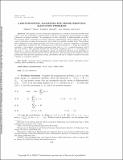A Decomposition Algorithm for Nested Resource Allocation Problems
Author(s)
Maculan, Nelson; Vidal, Thibaut Victor Gaston; Jaillet, Patrick
DownloadA Decomposition Algorithm.pdf (790.9Kb)
PUBLISHER_POLICY
Publisher Policy
Article is made available in accordance with the publisher's policy and may be subject to US copyright law. Please refer to the publisher's site for terms of use.
Terms of use
Metadata
Show full item recordAbstract
We propose an exact polynomial algorithm for a resource allocation problem with convex costs and constraints on partial sums of resource consumptions, in the presence of either continuous or integer variables. No assumption of strict convexity or differentiability is needed. The method solves a hierarchy of resource allocation subproblems, whose solutions are used to
convert constraints on sums of resources into new bounds for variables at higher levels. The resulting time complexity for the integer problem is O(n log m log(B/n)), and the complexity of obtaining an ∈-approximate solution for the continuous case is O(n log m log(B/∈)), n being the number of
variables, m the number of ascending constraints (such that m ≤ n), ∈ a desired precision, and B the total resource. This algorithm matches the best-known complexity when m = n and improves it when log m = o(log n). Extensive experimental analyses are presented with four recent algorithms on various continuous problems issued from theory and practice. The proposed method achieves a better performance than previous algorithms, solving all problems with up to 1 million variables in less than 1 minute on a modern computer.
Date issued
2016-06Department
Massachusetts Institute of Technology. Department of Electrical Engineering and Computer Science; Massachusetts Institute of Technology. Laboratory for Information and Decision SystemsJournal
SIAM Journal on Optimization
Publisher
Society for Industrial and Applied Mathematics
Citation
Vidal, Thibaut, Patrick Jaillet, and Nelson Maculan. “A Decomposition Algorithm for Nested Resource Allocation Problems.” SIAM Journal on Optimization 26.2 (2016): 1322–1340. © 2016 Society for Industrial and Applied Mathematics
Version: Final published version
ISSN
1052-6234
1095-7189